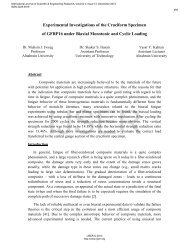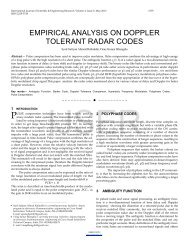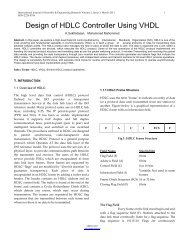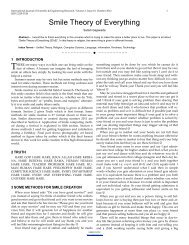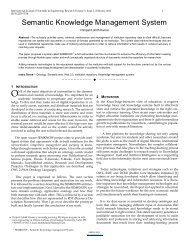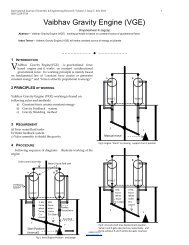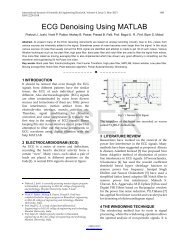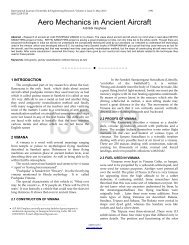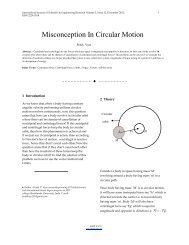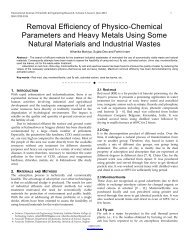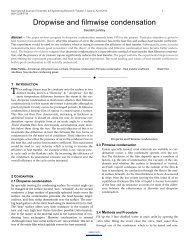A Fixed Point Theorem in Modified Intuitionistic Fuzzy Metric Spaces
A Fixed Point Theorem in Modified Intuitionistic Fuzzy Metric Spaces
A Fixed Point Theorem in Modified Intuitionistic Fuzzy Metric Spaces
You also want an ePaper? Increase the reach of your titles
YUMPU automatically turns print PDFs into web optimized ePapers that Google loves.
International Journal of Scientific & Eng<strong>in</strong>eer<strong>in</strong>g Research Volume 4, Issue 1, January-2013 1<br />
ISSN 2229-5518<br />
A <strong>Fixed</strong> <strong>Po<strong>in</strong>t</strong> <strong>Theorem</strong> <strong>in</strong> <strong>Modified</strong><br />
<strong>Intuitionistic</strong> <strong>Fuzzy</strong> <strong>Metric</strong> <strong>Spaces</strong><br />
Syed Shahnawaz Ali 1 , Dr. Ja<strong>in</strong>endra Ja<strong>in</strong> 2 , Dr. Anil Rajput 3<br />
Abstract— <strong>Fuzzy</strong> Mathematics has seen an enormous growth s<strong>in</strong>ce the <strong>in</strong>troduction of notion of fuzzy sets by Zadeh <strong>in</strong> 1965. Kramosil<br />
and Michalek <strong>in</strong>troduced the notion of fuzzy metric spaces which was later modified by George and Veeramani and others. The notion of<br />
<strong>in</strong>tuitionistic fuzzy metric spaces was <strong>in</strong>troduced by Park <strong>in</strong> 2004. Many authors have studied fixed po<strong>in</strong>t and common fixed theorems for<br />
mapp<strong>in</strong>gs on fuzzy metric spaces and <strong>in</strong>tuitionistic fuzzy metric spaces. In this paper we prove a common fixed po<strong>in</strong>t theorem for a<br />
sequence of mapp<strong>in</strong>gs <strong>in</strong> an <strong>in</strong>tuitionistic fuzzy metric space.<br />
Index Terms— <strong>Fixed</strong> <strong>Po<strong>in</strong>t</strong>s, <strong>Fuzzy</strong> sets, <strong>Fuzzy</strong> <strong>Metric</strong> <strong>Spaces</strong>, <strong>Intuitionistic</strong> <strong>Fuzzy</strong> Sets, <strong>Intuitionistic</strong> <strong>Fuzzy</strong> <strong>Metric</strong> <strong>Spaces</strong>, Triangular<br />
Norm, Triangular Co norm.<br />
1 INTRODUCTION<br />
T<br />
he concept of fuzzy sets was <strong>in</strong>troduced by Zadeh [22] <strong>in</strong><br />
1965. S<strong>in</strong>ce then, with a view to utilize this concept <strong>in</strong><br />
topology and analysis, many authors have extensively<br />
developed the theory of fuzzy sets. In 1975, Kramosil and<br />
Michalek [7] <strong>in</strong>troduced the concept of a fuzzy metric space by<br />
generaliz<strong>in</strong>g the concept of a probabilistic metric space to the<br />
fuzzy situation. The concept of Kramosil and Michalek [7] of a<br />
fuzzy metric space was later modified by George and<br />
Veeramani [1] <strong>in</strong> 1994. In 1988, Grabeic [11], follow<strong>in</strong>g the<br />
concept of Kramosil and Michalek [7], obta<strong>in</strong>ed the fuzzy<br />
version of Banach’s fixed po<strong>in</strong>t theorem. Jungck [5] <strong>in</strong>troduced<br />
the notion of compatible mapp<strong>in</strong>gs <strong>in</strong> metric spaces and<br />
utilized the same as a tool to improve commutativity<br />
conditions <strong>in</strong> common fixed po<strong>in</strong>t theorems. This concept has<br />
frequently been employed to prove existence theorems on<br />
common fixed po<strong>in</strong>ts. In recent past, several authors proved<br />
various fixed po<strong>in</strong>t theorems employ<strong>in</strong>g relatively more<br />
general contractive conditions. However, the study of<br />
common fixed po<strong>in</strong>ts of non-compatible mapp<strong>in</strong>gs is also<br />
equally <strong>in</strong>terest<strong>in</strong>g which was <strong>in</strong>itiated by Pant [18]. The<br />
notion of <strong>Intuitionistic</strong> <strong>Fuzzy</strong> Sets was put forward by<br />
Atanassov [10] <strong>in</strong> 1986 and notion of <strong>Intuitionistic</strong> <strong>Fuzzy</strong><br />
<strong>Metric</strong> <strong>Spaces</strong> was given by Park [9] <strong>in</strong> 2004 employ<strong>in</strong>g the<br />
notions of cont<strong>in</strong>uous t −norm and cont<strong>in</strong>uous t − conorm.<br />
<strong>Fixed</strong> po<strong>in</strong>t theory is one of the most fruitful and effective<br />
tools <strong>in</strong> mathematics which has enormous applications <strong>in</strong><br />
several branches of science especially <strong>in</strong> chaos theory, game<br />
theory, theory of differential equation, etc. <strong>Intuitionistic</strong> fuzzy<br />
metric notion is also useful <strong>in</strong> model<strong>in</strong>g some physical<br />
problems where<strong>in</strong> it is necessary to study the relationship<br />
between two probability functions as noticed by Gregori et al.<br />
[21]. For <strong>in</strong>stance, it has a concrete physical visualization <strong>in</strong> the<br />
————————————————<br />
1. Syed Shahnawaz Ali is work<strong>in</strong>g as Assisstant Professor <strong>in</strong> Mathematics at<br />
Sagar Institute of Research, Technology & Science, Bhopal, India. E-mail:<br />
shahnawaz_hunk@yahoo.com<br />
2. Dr. Ja<strong>in</strong>endra Ja<strong>in</strong> is work<strong>in</strong>g as Professor <strong>in</strong> Mathematics at Sagar Institute<br />
of Research, Technology & Science, Bhopal, India. E-mail:<br />
jj.28481@gmail.com<br />
3. Dr. Anil Rajput is work<strong>in</strong>g as Professor <strong>in</strong> Mathematics at Chandra Shekhar<br />
Azad P. G. College, Sehore, India. E-mail: dranilrajput@hotmail.com<br />
—————————— ——————————<br />
IJSER © 2013<br />
http://www.ijser.org<br />
context of two slit experiment as the foundation of E −<strong>in</strong>f<strong>in</strong>ity<br />
theory of high energy physics whose details are available <strong>in</strong> El<br />
Naschie <strong>in</strong> [12], [13], [14]. The topology <strong>in</strong>duced by<br />
<strong>in</strong>tuitionistic fuzzy metric co<strong>in</strong>cides with the topology<br />
<strong>in</strong>duced by fuzzy metric as noticed by Gregori et al. [21].<br />
Follow<strong>in</strong>g this, Saadati et al. [17] reframed the idea of<br />
<strong>in</strong>tuitionistic fuzzy metric spaces and proposed a new notion<br />
under the name of modified <strong>in</strong>tuitionistic fuzzy metric spaces<br />
by <strong>in</strong>troduc<strong>in</strong>g the notion of cont<strong>in</strong>uous t − representable<br />
norm.<br />
<strong>Fixed</strong> po<strong>in</strong>t and common fixed po<strong>in</strong>t properties for mapp<strong>in</strong>gs<br />
def<strong>in</strong>ed on fuzzy metric spaces <strong>in</strong>tuitionistic fuzzy metric<br />
spaces and L − fuzzy metric spaces have been studied by<br />
many authors like H. Adibi et al. [6], S. Sharma [19], J. Goguen<br />
[8], V. Gregori and A. Sapena [20], C. Alaca et al. [2], Saadati et<br />
al. [15], [16]. Most of the properties which provide the<br />
existence of fixed po<strong>in</strong>ts and common fixed po<strong>in</strong>ts are of l<strong>in</strong>ear<br />
contractive type conditions.<br />
In this paper we prove a common fixed po<strong>in</strong>t theorem for a<br />
sequence of mapp<strong>in</strong>gs <strong>in</strong> <strong>in</strong>tuitionistic fuzzy metric spaces<br />
<strong>in</strong>troduced by Park [9] and modified by Saadati et al. [17]. For<br />
the sake of completeness we recall some def<strong>in</strong>itions and<br />
results <strong>in</strong> the next section.<br />
2 PRELIMINARIES<br />
Def<strong>in</strong>ition 1: Let L = (L ∗ ,≤ ∗) be a complete lattice, and U a<br />
non empty set called a universe. An L −fuzzy set A on U is<br />
def<strong>in</strong>ed as amapp<strong>in</strong>g A: U → L ∗ . For each u <strong>in</strong> U, A(u)<br />
represents the degree (<strong>in</strong> L ∗ ) to which u satisfies A.<br />
Lemma 2: Consider the set L ∗ and operation ≤ ∗ def<strong>in</strong>ed by ∶<br />
L ∗ = {(x ,x ) ∶ (x , x ) ∈ [0, 1] & x + x ≤ 1},<br />
(x , x ) ≤ ∗ (y , y ) ⟺ x ≤ y <br />
and x ≥ y , for every (x , x ), (y ,y ) ∈ L ∗ .<br />
Then, L ∗ , ≤ ∗) is a complete lattice.<br />
Def<strong>in</strong>ition 3: An <strong>in</strong>tuitionistic fuzzy set A , <strong>in</strong> a universe U<br />
is an object A , = {(ζ A (u), η A (u))|u ∈ U}, where, for all<br />
u ∈ U, ζ A (u) ∈ [0, 1] and η A (u) ∈ [0, 1] are called the
International Journal of Scientific & Eng<strong>in</strong>eer<strong>in</strong>g Research Volume 4, Issue 1, January-2013 2<br />
ISSN 2229-5518<br />
membership degree and the non-membership degree,<br />
respectively of u <strong>in</strong> A , and furthermore they satisfy<br />
ζ A (u) + η A (u) ≤ 1.<br />
Def<strong>in</strong>ition 4: For every z = (x ,y ) ∈ L ∗ we def<strong>in</strong>e<br />
∨ (z ) = sup(x ),<strong>in</strong>f(y ).<br />
S<strong>in</strong>ce z ∈ L ∗ then x + y ≤ 1 so sup(x ) + <strong>in</strong>f (y ) ≤<br />
sup(x + y ) ≤ 1, that is ∨ (z ) ∈ L ∗ . We denote its units by<br />
0 ∗ = (0, 1) and 1 ∗ = (1, 0).<br />
Classically, a triangular norm ∗ = T on ([0,1], ≤) is def<strong>in</strong>ed as<br />
an <strong>in</strong>creas<strong>in</strong>g, commutative, associative mapp<strong>in</strong>g T: [0,1] →<br />
[0,1] satisfy<strong>in</strong>g T(1, x) = 1 ∗ x = x, for all x ∈ [0,1]. A<br />
triangular conorm S = ◊ is def<strong>in</strong>ed as an <strong>in</strong>creas<strong>in</strong>g,<br />
commutative, associative mapp<strong>in</strong>g S: [0,1] → [0,1] satisfy<strong>in</strong>g<br />
S(0, x) = 0 ◊ x = x, for all x ∈ [0,1]. Us<strong>in</strong>g the lattice (L ∗ , ≤ ∗)<br />
these def<strong>in</strong>itions can be straightforwardly extended.<br />
Def<strong>in</strong>ition 5: [3, 4] A triangular norm (t–norm) on L ∗ is a<br />
mapp<strong>in</strong>g T ∶ (L ∗ ) → L ∗ satisfy<strong>in</strong>g the follow<strong>in</strong>g conditions:<br />
1) (∀x ∈ L ∗ )(T (x, 1 ∗) = x), (boundary condition)<br />
2) (∀(x, y) ∈ (L ∗ ) )T(x, y) = T(y, x), (commutativity)<br />
3) (∀(x, y, z) ∈ (L ∗ ) ) T x, T(y, z) = T (T (x, y), z),<br />
(associativity),<br />
4) (∀ (x, x’, y, y’) ∈ (L ∗ ) )(x ≤ ∗ x’) and y ≤ ∗ y’ ⟹<br />
T(x, y) ≤ ∗ T (x’, y’). (monotonicity).<br />
Def<strong>in</strong>ition 6: [3, 4] A cont<strong>in</strong>uous t–norm T on L ∗ is called<br />
cont<strong>in</strong>uous t– representable if and only if there exist a<br />
cont<strong>in</strong>uous t–norm ∗ and a cont<strong>in</strong>uous t–conorm ◊ on [0, 1]<br />
such that, for all x = (x , x ), y = (y , y ) ∈ L ∗ ,<br />
T (x, y) = (x ∗ y , x ◊ y ).<br />
Now def<strong>in</strong>e a sequence T recursively by T = T and<br />
T x () , ⋯ , x () = T(T x () , ⋯ , x () , x () )<br />
for n ≥ 2 and x () ∈ L ∗ .<br />
We say the cont<strong>in</strong>uous t–representable norm is natural and<br />
write T whenever T (a, b) = T (c, d) and a ≤ ∗ c implies<br />
b ≤ ∗ d.<br />
Def<strong>in</strong>ition 7: A negator on L ∗ is any decreas<strong>in</strong>g mapp<strong>in</strong>g<br />
N ∶ L ∗ → L ∗ satisfy<strong>in</strong>g N(0 ∗) = 1 ∗ and N(1 ∗) = 0 ∗ . If<br />
N(N(x)) = x, for all x ∈ L ∗ , then N is called an <strong>in</strong>volutive<br />
negator. A negator on [0, 1] is a decreas<strong>in</strong>g mapp<strong>in</strong>g<br />
N: [0, 1] → [0, 1] satisfy<strong>in</strong>g N(0) = 1 and N(1) = 0. N <br />
denotes the standard negator on [0, 1] def<strong>in</strong>ed as N (x) = 1 −<br />
x for all x ε [0, 1].<br />
Def<strong>in</strong>ition 8: Let M, N are fuzzy sets from X × (0, +∞) to<br />
[0, 1] such that M(x, y, t) + N(x, y, t) ≤ 1 for all x, y ∈ X and<br />
t > 0. The 3 −tuple X, M , , T is said to be an <strong>in</strong>tuitionistic<br />
fuzzy metric space if X is an arbitrary (non-empty) set, T is a<br />
cont<strong>in</strong>uous t − representable norm and M , is a mapp<strong>in</strong>g<br />
X × (0, +∞) → L ∗ (an <strong>in</strong>tuitionistic fuzzy set, see Def<strong>in</strong>ition 3)<br />
satisfy<strong>in</strong>g the follow<strong>in</strong>g conditions for every x, y ∈ X and<br />
t, s > 0:<br />
1) M , (x, y, t) > ∗ 0 ∗;<br />
2) M , (x, y, t) = 1 ∗ if and only if x = y;<br />
3) M , (x, y, t) = M , (y, x, t);<br />
4) M , (x, y, t + s )<br />
≥ ∗ T M , (x, z, t), M , (z, y, s) ;<br />
5) M , (x, y,·): (0, ∞) → L ∗ is cont<strong>in</strong>uous.<br />
In this case M , is called an <strong>in</strong>tuitionistic fuzzy metric space.<br />
Here, M , (x, y, t) = (M(x, y, t ), N(x, y, t )).<br />
Example 9: Let (X, d) be a metric space. Def<strong>in</strong>e T(a, b) =<br />
{a b , m<strong>in</strong>(a + b , 1)} for all a = (a ,a ) and b = (b , b ) ∈ L ∗<br />
and let M and N be fuzzy sets on X × (0, ∞) def<strong>in</strong>ed as<br />
follows:<br />
M , (x, y, t) = M(x, y, t ), N(x, y, t)<br />
ht <br />
= <br />
ht + md(x, y) , md(x, y)<br />
ht + md(x, y) ,<br />
for all h, m, n, t ∈ R . Then (X, M , , T ) is an <strong>in</strong>tuitionistic<br />
fuzzy metric space.<br />
Example 10: Let X = N. Def<strong>in</strong>e T(a, b) = {(max(0, a + b −<br />
1), a + b − a b } for all a = (a , a ) and b = (b ,b ) ∈ L ∗<br />
and let M and N be fuzzy sets on X × (0, ∞) def<strong>in</strong>ed as<br />
follows:<br />
x y − x<br />
, if x ≤ y<br />
y y<br />
M , (x, y, t) = M(x, y, t ), N(x, y, t) = <br />
y x − y<br />
, if y ≤ x<br />
x x<br />
for all x, y ε X and t > 0. Then (X, M , , T ) is an <strong>in</strong>tuitionistic<br />
fuzzy metric space.<br />
Def<strong>in</strong>ition 11: Let (X, M , , T ) be an <strong>in</strong>tuitionistic fuzzy<br />
metric space and {x } be a sequence <strong>in</strong> X.<br />
1) A sequence {x } is said to be convergent to x ∈ X <strong>in</strong><br />
the <strong>in</strong>tuitionistic fuzzy metric space X, M , , T and<br />
M ,<br />
denoted by x ⎯⎯ x if M , (x ,x, t) → 1 ∗ as n → ∞<br />
for every t > 0.<br />
2) A sequence {x } <strong>in</strong> an <strong>in</strong>tuitionistic fuzzy metric space<br />
X, M , , T is called a Cauchy sequence if for each<br />
0 < ε < 1 and t > 0, there exists n ∈ N such that<br />
M , (x , x , t) > ∗ (N (ε), ε), and for each n, m ≥ n ;<br />
here N is the standard negator.<br />
3) An <strong>in</strong>tuitionistic fuzzy metric space is said to be<br />
complete if and only if every Cauchy sequence <strong>in</strong> this<br />
space is convergent. Henceforth, we assume that T is<br />
a cont<strong>in</strong>uous t −norm on the lattice L such that for<br />
every μ ∈ L ∗ \ {0 ∗, 1 ∗}, there exists λ ∈ L ∗ \ {0 ∗, 1 ∗}<br />
such that T (N(λ), ⋯ , N(λ)) ≥ ∗ N(μ).<br />
Lemma 12: Let M , be an <strong>in</strong>tuitionistic fuzzy metric. Then for<br />
any t > 0 , M , (x, y, t) is nondecreas<strong>in</strong>g with respect to t <strong>in</strong><br />
( L ∗ ,≤ ∗) for all x, y ∈ X.<br />
Def<strong>in</strong>ition 13: Let (X, M , , T ) be an <strong>in</strong>tuitionistic fuzzy<br />
metric space. For t > 0, we def<strong>in</strong>e the open ball B(x, r, t ) with<br />
center x ∈ X and 0 < r < 1 by<br />
B(x, r, t) = y ∈ X ∶ M , (x, y, t) > ∗ (N (r), r).<br />
A subset A ⊂ X is called open if for each x ∈ A, there exist<br />
t > 0 and 0 < r < 1 such that B(x, r, t) ⊂ A. Let T M, denote<br />
the family of all open subset of X. T M, is called the topology<br />
<strong>in</strong>duced by the <strong>in</strong>tuitionistic fuzzy metric space.<br />
IJSER © 2013<br />
http://www.ijser.org
International Journal of Scientific & Eng<strong>in</strong>eer<strong>in</strong>g Research Volume 4, Issue 1, January-2013 3<br />
ISSN 2229-5518<br />
Def<strong>in</strong>ition 14: Let (X, M , , T ) be an <strong>in</strong>tuitionistic fuzzy<br />
metric space. A subset A of X is said to be IF −bounded if<br />
there exist t > 0 and 0 < r < 1 such that<br />
M , (x, y, t) > ∗ (N (r),r) for each x, y ∈ A.<br />
Def<strong>in</strong>ition 15: Let (X, M , , T ) be an <strong>in</strong>tuitionistic fuzzy<br />
metric space. M is said to be cont<strong>in</strong>uous on X × X × ]0, ∞[ if<br />
lim M ,(x , y , t ) = M , (x, y, t)<br />
→∞<br />
whenever {(x , y , t )} is a sequence <strong>in</strong> X × X × ]0, ∞[ which<br />
converges to a po<strong>in</strong>t<br />
(x, y, t) ∈ X × X × ]0, ∞[ i. e. , lim<br />
→∞<br />
M , (x , x, t)<br />
= lim<br />
→∞<br />
M , (y , y, t) = 1 ∗<br />
and lim →∞ M , (x, y, t ) = M , (x, y, t).<br />
Lemma 16: Let (X, M , , T ) be an <strong>in</strong>tuitionistic fuzzy metric<br />
space and def<strong>in</strong>e E ,M, ∶ X → R ∪ {0} by<br />
E ,M, (x, y) = <strong>in</strong>f{t > 0 ∶ M , (x, y, t) > ∗ N(λ)}<br />
for each λ ∈ L ∗ \ {0 ∗, 1 ∗} and x, y ∈ X here, N is an <strong>in</strong>volutive<br />
negator. Then we have<br />
(i) For any μ ∈ L ∗ \ {0 ∗, 1 ∗}, there exists λ ∈ L ∗ \ {0 ∗, 1 ∗} such<br />
that E ,M, (x , x ) ≤ E ,M, (x ,x ) + E ,M, (x , x ) + ⋯ +<br />
E ,M, (x , x ) for any x ,x , x , ⋯ x ∈ X.<br />
(ii) The sequence {x } ∈N is convergent to x with respect to<br />
<strong>in</strong>tuitionistic fuzzy metric M , if and only if E ,M, (x , x) → 0.<br />
Also, the sequence {x } is a Cauchy sequence with respect to<br />
<strong>in</strong>tuitionistic fuzzy metric M , if and only if it is a Cauchy<br />
sequence with E ,M, .<br />
Lemma 17: Let (X, M , , T) be an <strong>in</strong>tuitionistic fuzzy metric<br />
space. If<br />
t<br />
M , (x , x , t) ≥ ∗ M , x ,x ,<br />
k <br />
for some k < 1 and n ε N then {x } is a Cauchy sequence.<br />
We now extend the above def<strong>in</strong>itions and results.<br />
Def<strong>in</strong>ition 18: Let M, N are fuzzy sets from X × (0, +∞) to<br />
[0, 1]such that M(x, y , z, t) + N(x, y , z, t) ≤ 1 for all x, y, z ∈<br />
X and t > 0. The 3 − tuple X, M , , T is said to be an<br />
<strong>in</strong>tuitionistic fuzzy metric space if X is an arbitrary (nonempty)<br />
set, T is a cont<strong>in</strong>uous t −representable and M , is a<br />
mapp<strong>in</strong>g X × (0, +∞) → L ∗ (an <strong>in</strong>tuitionistic fuzzy set, see<br />
Def<strong>in</strong>ition 3) satisfy<strong>in</strong>g the follow<strong>in</strong>g conditions for every<br />
x, y, z , w ∈ X and t, s > 0:<br />
1) M , (x, y, z, t) > ∗ 0 ∗;<br />
2) M , (x, y, z, t) = 1 ∗ if and only if x = y = z;<br />
3) M , (x, y, z, t) = M , (x, z, y, t) = M , (y, z, x, t);<br />
4) M , (x, y, z, t + s )<br />
≥ ∗ T M , (x, y, w, t), M , (w, z, z , s) ;<br />
5) M , (x, y, z,·) ∶ (0, ∞) → L ∗ is cont<strong>in</strong>uous.<br />
In this case M , is called an <strong>in</strong>tuitionistic fuzzy metric. Here,<br />
M , (x, y, z, t) = (M(x, y, z, t ),N(x, y, z, t )).<br />
Example 19: Let (X, d) be a metric space. Def<strong>in</strong>e T(a, b) =<br />
(a b , a b , m<strong>in</strong> {a + b , 1}) for all a = (a , a , a ) and b =<br />
(b ,b , b ) ∈ L ∗ and let M and N be fuzzy sets on X ×<br />
(0, ∞) def<strong>in</strong>ed as follows:<br />
M , (x, y, z, t) = M(x, y, z t ), N(x, y, z , t)<br />
ht <br />
= <br />
ht + md(x, y, z) , md(x, y, z)<br />
ht + md(x, y, z) ,<br />
for all h, m, n, t ∈ R . Then (X, M , , T ) is an <strong>in</strong>tuitionistic<br />
fuzzy metric space.<br />
Def<strong>in</strong>ition 20: Let (X, M , , T ) be an <strong>in</strong>tuitionistic fuzzy<br />
metric space and {x } be a sequence <strong>in</strong> X.<br />
1) A sequence {x } is said to be convergent to x ∈ X <strong>in</strong><br />
the <strong>in</strong>tuitionistic fuzzy metric space X, M , , T and<br />
M ,<br />
denoted by x ⎯⎯ x if M , (x ,x, x, t) → 1 ∗ as<br />
n → ∞ for every t > 0.<br />
2) A sequence {x } <strong>in</strong> an <strong>in</strong>tuitionistic fuzzy metric space<br />
X, M , , T is called a Cauchy sequence if for each<br />
0 < ε < 1 and t > 0, there exists n ∈ N such that<br />
M , (x , x , x , t) > ∗ (N (ε), ε), and for each<br />
n, m ≥ n ; here N is the standard negator.<br />
3) An <strong>in</strong>tuitionistic fuzzy metric space is said to be<br />
complete if and only if every Cauchy sequence <strong>in</strong> this<br />
space is convergent.<br />
Lemma 21: Let M , be an <strong>in</strong>tuitionistic fuzzy metric. Then<br />
for any t > 0 , M , (x, y, z, t) is nondecreas<strong>in</strong>g with respect to<br />
t <strong>in</strong> ( L ∗ ,≤ ∗) for all x, y, z ∈ X.<br />
Def<strong>in</strong>ition 22: Let (X, M , , T ) be an <strong>in</strong>tuitionistic fuzzy<br />
metric space. For t > 0, we def<strong>in</strong>e the open ball B(x, r, t ) with<br />
center x ∈ X and 0 < r < 1 by<br />
B(x, r, t) = y ∈ X ∶ M , (x, y, y, t) > ∗ (N (r),r)<br />
A subset A ⊂ X is called open if for each x ∈ A, there exist<br />
t > 0 and 0 < r < 1 such that B(x, r, t) ⊂ A. Let T M, denote<br />
the family of all open subset of X. T M, is called the topology<br />
<strong>in</strong>duced by the <strong>in</strong>tuitionistic fuzzy metric space.<br />
Def<strong>in</strong>ition 23: Let (X, M , , T ) be an <strong>in</strong>tuitionistic fuzzy<br />
metric space. M is said to be cont<strong>in</strong>uous on X × (0, ∞) if<br />
lim M ,(x , y , z , t ) = M , (x, y, z, t)<br />
→∞<br />
Whenever {(x , y , z , t )} is a sequence <strong>in</strong> X × (0, ∞) which<br />
converges to a po<strong>in</strong>t (x, y, z, t) ∈ X × (0, ∞), i. e.,<br />
lim →∞ x = x, lim →∞ y = y, lim →∞ z = z, and<br />
lim M ,(x, y, z, t ) = M , (x, y, z, t).<br />
→∞<br />
Lemma 24: Let (X, M , , T ) be an <strong>in</strong>tuitionistic fuzzy metric<br />
space and def<strong>in</strong>e E ,M, ∶ X → R ∪ {0} by<br />
E ,M, (x, y, z) = <strong>in</strong>f{t > 0 ∶ M , (x, y, z, t) > ∗ N(λ)}<br />
for each λ ∈ L ∗ \ {0 ∗, 1 ∗} and x, y, z ∈ X here, N is an <strong>in</strong>volutive<br />
negator. Then we have<br />
IJSER © 2013<br />
http://www.ijser.org
International Journal of Scientific & Eng<strong>in</strong>eer<strong>in</strong>g Research Volume 4, Issue 1, January-2013 4<br />
ISSN 2229-5518<br />
(i) For any μ ∈ L ∗ {0 ∗, 1 ∗} there exists λ ∈ L ∗ {0 ∗, 1 ∗} such that<br />
E ,M, (x , x , x ) ≤ E ,M, (x ,x , x ) + E ,M, (x ,x , x ) +<br />
⋯ + E ,M, (x , x , x ) for any x , x ,x , ⋯ x ∈ X.<br />
(ii) The sequence {x } ∈N is convergent with respect to<br />
<strong>in</strong>tuitionistic fuzzy metric M , if and only if E ,M, (x , x, x) →<br />
0. Also the sequence {x } is a Cauchy sequence with respect to<br />
<strong>in</strong>tuitionistic fuzzy metric M , if and only if it is a Cauchy<br />
sequence with E ,M, .<br />
Proof: For (i), by the cont<strong>in</strong>uity of t − norms, for every<br />
μ ∈ L ∗ \ {0 ∗, 1 ∗}, we can f<strong>in</strong>d a λ ∈ L ∗ \{0 ∗, 1 ∗} such that<br />
T(N(λ), N(λ)) ≥ ∗ N(μ). By def<strong>in</strong>ition 18 , we have<br />
M , (x, y , z, E ,M, (x , x , x ) + E ,M, (x , x ,x ) + ⋯<br />
+E ,M, (x , x , x ) + nδ)<br />
≥ ∗ T ( M , (x, y, w, E ,M, (x , x , x ) + E ,M, (x , x , x )<br />
+ ⋯ + E ,M, (x , x , x ) + nδ 2 ),<br />
M , (w, z, z , E ,M, (x , x ,x )<br />
+E ,M, (x ,x , x ) + nδ 2 ))<br />
= <strong>in</strong>f{t > 0 ∶ M , (x , x , x ,t) > ∗ N(λ)}<br />
t<br />
≤ <strong>in</strong>f{t > 0 ∶ M , x ,x , x ,<br />
k > ∗ N(λ)}<br />
= <strong>in</strong>f{ k t ∶ M , (x , x , x ,t) > ∗ N(λ)}<br />
= k <strong>in</strong>f{t > 0 ∶ M , (x , x , x , t) > ∗ N(λ)}<br />
= k E ,M, (x ,x , x , t)<br />
From lemma (24), for every μ ε L ∗ \{0 ∗, 1 ∗} there exists<br />
λ ∈ L ∗ \ {0 ∗, 1 ∗}, such that<br />
E ,M, (x ,x , x )<br />
≤ E ,M, (x , x , x ) + E ,M, (x ,x , x ) + ⋯<br />
+E ,M, (x , x , x )<br />
≤ k E ,M, (x , x , x ) + k E ,M, (x ,x , x ) + ⋯<br />
<br />
= E ,M, (x , x ,x ) k ⟶ 0.<br />
<br />
+k E ,M, (x ,x , x )<br />
Hence sequence {x } is a Cauchy sequence.<br />
3 THE MAIN RESULT<br />
≥ ∗ T (N(λ), N(λ)) ≥ ∗ N(μ)<br />
for every δ > 0, which implies that<br />
E ,M, (x , x , x ) ≤ E ,M, (x , x , x ) + E ,M, (x , x , x )<br />
+ ⋯ + E ,M, (x ,x , x ) + nδ<br />
S<strong>in</strong>ce δ > 0 was arbitrary, we have<br />
E ,M, (x , x ,x ) ≤ E ,M, (x , x , x ) + E ,M, (x , x , x )<br />
+ ⋯ + E ,M, (x , x , x ).<br />
For (ii), we have<br />
M , (x , x, x, η) > ∗ N(λ) ⟺ E ,M, (x ,x, x) < η<br />
for every η > 0.<br />
Lemma 25: Let (X, M , , T) be an <strong>in</strong>tuitionistic fuzzy metric<br />
space. If<br />
t<br />
M , (x , x , x , t) ≥ ∗ M , x , x , x ,<br />
k <br />
for some k < 1 and n ε N then {x } is a Cauchy sequence.<br />
Proof: For every λ ε L\{0 ∗, 1 ∗} and x ε X, we have<br />
E ,M, (x , x ,x , t)<br />
IJSER © 2013<br />
http://www.ijser.org<br />
<strong>Theorem</strong> 1: Let {A } be a sequence of mapp<strong>in</strong>gs A of a complete<br />
<strong>in</strong>tuitionistic fuzzy metric space (X, M , , T ) <strong>in</strong>to itself such that,<br />
for any three mapp<strong>in</strong>gs A , A , A <br />
M , A (x),A (y), A (z),α ,, t ≥ ∗ M , (x, y, z, t)<br />
for some m; here 0 < α ,, < k < 1 for i, j, l = 1, 2, ⋯ , x, y, z ∈<br />
X and t > 0. Then the sequence {A } has a unique common fixed<br />
po<strong>in</strong>t <strong>in</strong> X.<br />
Proof: Let x be an arbitrary po<strong>in</strong>t <strong>in</strong> X and def<strong>in</strong>e a sequence<br />
{x } <strong>in</strong> X by x = A (x ),x = A (x ), x = A (x ), ⋯ . Then<br />
we have<br />
M , (x , x , x ,t) = M , (A (x ), A (x ),A (x ), t)<br />
t<br />
≥ ∗ M , x , x , x , ,<br />
α ,,<br />
M , (x , x ,x , t) = M , (A (x ), A (x ),A (x ), t)<br />
≥ ∗ M , (x , x , x ,<br />
≥ ∗ M , x , x ,x ,<br />
and so on. By <strong>in</strong>duction, we have<br />
<br />
)<br />
,,<br />
<br />
<br />
,, ,,<br />
M , (x ,x , x , t) ≥ ∗ M , x ,x , x ,<br />
∏<br />
for n = 1,2,3 ⋯, which implies<br />
t<br />
<br />
<br />
α ,,
International Journal of Scientific & Eng<strong>in</strong>eer<strong>in</strong>g Research Volume 4, Issue 1, January-2013 5<br />
ISSN 2229-5518<br />
E ,M, (x , x ,x , t)<br />
as n → ∞. Therefore, for<br />
1 ∗ ,i. e. , x = y. Also<br />
every t > 0, we have M(x, x, y, t) =<br />
A (x) = A A (x) = A A (x), i. e.,<br />
≥ ∗ M , (x, x, y, <br />
) ≥ ∗ · · · ≥ ∗ M <br />
,(x, x, y,<br />
) → 1 [16] R. Saadati, A. Razani, H. Adibi, “A Common <strong>Fixed</strong> <strong>Po<strong>in</strong>t</strong> <strong>Theorem</strong> <strong>in</strong><br />
∗ L − <strong>Fuzzy</strong> <strong>Metric</strong> <strong>Spaces</strong>,” Chaos, Solitons and Fractals, vol. 33, pp. 358<br />
= <strong>in</strong>f{t > 0 ∶ M , (x , x , x , t) > ∗ N(λ)}<br />
A (x) is also a periodic po<strong>in</strong>t of A . Therefore, x =<br />
A (x), i. e. , x is a unique common fixed periodic po<strong>in</strong>t of the<br />
t<br />
mapp<strong>in</strong>gs A<br />
≤ <strong>in</strong>f{t > 0 ∶ M , x , x , x ,<br />
<br />
><br />
∏<br />
α ∗ N(λ)}<br />
for n = 1, 2, ⋯ . This completes the proof.<br />
,,<br />
<br />
4 CONCLUSIONS<br />
= <strong>in</strong>f{ α ,, t > 0 ∶ M , (x ,x , x , t) > ∗ N(λ)}<br />
In this paper we have proved a common fixed po<strong>in</strong>t theorem<br />
<br />
<br />
for a sequence of mapp<strong>in</strong>gs for the modified <strong>in</strong>tuitionistic<br />
= α ,, <strong>in</strong>f{t > 0 ∶ M , (x , x , x , t) > ∗ N(λ)} fuzzy metric spaces def<strong>in</strong>ed us<strong>in</strong>g the notion of cont<strong>in</strong>uous t –<br />
<br />
<br />
= α ,, E ,M, (x ,x , x , ) ≤ k E ,M, (x ,x , x , )<br />
representable norms. The result can be extended for more<br />
general conditions.<br />
<br />
for every λ L ∗ \ {0 ∗, 1 ∗}.<br />
5 REFERENCES<br />
Now, we show that {x } is a Cauchy sequence. For every [1] A. George and P. Veeramani, “On Some Results <strong>in</strong> <strong>Fuzzy</strong> <strong>Metric</strong><br />
µ L ∗ \ {0 ∗, 1 ∗}, there exists γ L ∗ \ {0 ∗, 1 ∗} such that<br />
<strong>Spaces</strong>,” <strong>Fuzzy</strong> Sets and Systems, vol. 64, pp. 395-399, 1994.<br />
E ,M, (x ,x , x )<br />
[2] C. Alaca, D. Turkoglu and C. Yildiz, “<strong>Fixed</strong> <strong>Po<strong>in</strong>t</strong>s <strong>in</strong> <strong>Intuitionistic</strong><br />
<strong>Fuzzy</strong> <strong>Metric</strong> <strong>Spaces</strong>,” Chaos, Solitons and Fractals, vol. 29, pp. 1073 –<br />
≤ E ,M, (x , x , x ) + E ,M, (x ,x , x ) + ⋯<br />
1078, 2006.<br />
[3] G. Deschrijver and E.E.Kerre, “On the Relationship between Some<br />
+E ,M, (x , x , x )<br />
Extensions of <strong>Fuzzy</strong> Set Theory,” <strong>Fuzzy</strong> sets and Systems, vol. 23, pp.<br />
227–235, 2003.<br />
≤ k E ,M, (x , x , x ) + k E ,M, (x ,x , x ) + ⋯<br />
[4] G. Deschrijver, C. Corenelis and E.E.Kerre, “On the Representation of<br />
<strong>Intuitionistic</strong> <strong>Fuzzy</strong> t −norms and t −conorms,” IEEE Transactions on<br />
+k E ,M, (x ,x , x )<br />
<strong>Fuzzy</strong> Systems, vol. 12, pp. 45–61, 2004.<br />
[5] G. Jungck, “Compatible Mapp<strong>in</strong>gs and Common <strong>Fixed</strong> <strong>Po<strong>in</strong>t</strong>s”<br />
<br />
= E ,M, (x , x ,x ) k <br />
International Journal of Mathematics and Mathematical Sciences, vol. 09,<br />
⟶ 0.<br />
pp 771 – 779, 1986.<br />
<br />
[6] H. Adibi, Y. J. Cho, D. O` Regan and R. Saadati, “Common <strong>Fixed</strong><br />
As m, n → ∞. S<strong>in</strong>ce X is left complete, there is x X such that <strong>Po<strong>in</strong>t</strong> <strong>Theorem</strong>s <strong>in</strong> L − <strong>Fuzzy</strong> <strong>Metric</strong> <strong>Spaces</strong>,” Appl. Math. Comp., vol.<br />
lim →∞ x = x. Now we prove that x is a periodic po<strong>in</strong>t of A 182, pp. 820–828, 2006.<br />
for any i = 1, 2, ⋯, we have<br />
M , (x, x, A [7] I. Kramosil and J. Michalek, “<strong>Fuzzy</strong> <strong>Metric</strong> and Statistical <strong>Metric</strong><br />
(x), t)<br />
≥ ∗ T (M , (x, x, x , t − kt), M , (x , A (x), A <strong>Spaces</strong>,” Kybernetica, vol. 11, pp. 326–334, 1975.<br />
(x), kt))<br />
[8] J. Goguen, “L −<strong>Fuzzy</strong> Sets,” J. Math. Anal. Appl., vol. 18, pp. 145 –<br />
= T(M , (x, x, x , t(1 − k)),<br />
M , (A 174, 1967.<br />
(x ), A (x), A (x), kt))<br />
[9] J.H. Park, “<strong>Intuitionistic</strong> <strong>Fuzzy</strong> <strong>Metric</strong> <strong>Spaces</strong>,” Chaos, Solitons and<br />
≥ ∗ T (M , (x, x, x , t(1 − k)),<br />
M , (A Fractals, vol. 22, pp. 1039 – 1046, 2004.<br />
(x ), A (x), A (x), α ,, t))<br />
[10] K.T. Atanassov, “<strong>Intuitionistic</strong> <strong>Fuzzy</strong> Sets,” <strong>Fuzzy</strong> sets and Systems,<br />
≥ ∗ T (M , (x, x, x , t(1 − k)), M , (x , x, x, t))<br />
vol. 20, pp. 87–96, 1986.<br />
→ T (1 ∗, 1 ∗) = 1 ∗<br />
as n → ∞. Thus M , (x, x, A (x), t) = 1 ∗ and we get A [11] M. Grabiec, “<strong>Fixed</strong> <strong>Po<strong>in</strong>t</strong>s <strong>in</strong> <strong>Fuzzy</strong> <strong>Metric</strong> <strong>Spaces</strong>,” <strong>Fuzzy</strong> Sets and<br />
(x) =<br />
x.<br />
Systems, vol. 27, pp. 385 – 389, 1988.<br />
To show uniqueness, assume that y ≠ x is another periodic<br />
po<strong>in</strong>t of A . Then we have<br />
[12] M.S. El Naschie, “A Review of E − Inf<strong>in</strong>ity Theory and the Mass<br />
Spectrum of High Energy Particle Physics,” Chaos, Solitons and<br />
Fractals, vol. 19, pp. 209 – 236, 2004.<br />
1 ∗ ≥ ∗ M , (x, x, y, t) = M , (A (x), A (x), A (y), t)<br />
[13] M.S. El Naschie, “On Two New <strong>Fuzzy</strong> Kahler Manifolds, Kle<strong>in</strong><br />
Modular Space and t Hooft Holographic Pr<strong>in</strong>ciples,” Chaos, Solitons<br />
t<br />
≥ ∗ M , (x, x, y, )<br />
and Fractals, vol. 29, pp. 876 – 881, 2006.<br />
α ,, [14] M.S. El Naschie, “The Idealized Quantum Two - Slit Gedanken<br />
Experiment Revisited - Criticism and Re<strong>in</strong>terpretation,” Chaos,<br />
≥ ∗ M , (x, x, y, ) = M <br />
,(A (x), A (x), A Solitons and Fractals, vol. 27, pp. 843 – 849, 2006.<br />
(y), t/k)<br />
[15] R. Saadati and J.H. Park, “On the <strong>Intuitionistic</strong> <strong>Fuzzy</strong> Topological<br />
<strong>Spaces</strong>,” Chaos, Solitons and Fractals, vol. 27, pp. 331 –344, 2006.<br />
IJSER © 2013<br />
http://www.ijser.org<br />
–363, 2007.
International Journal of Scientific & Eng<strong>in</strong>eer<strong>in</strong>g Research Volume 4, Issue 1, January-2013 6<br />
ISSN 2229-5518<br />
[17] R. Saadati, S. Sedgi and N. Shobe, “<strong>Modified</strong> <strong>Intuitionistic</strong> <strong>Fuzzy</strong><br />
<strong>Metric</strong> <strong>Spaces</strong> and Some <strong>Fixed</strong> <strong>Po<strong>in</strong>t</strong> <strong>Theorem</strong>s,” Chaos, Solitons and<br />
Fractals, vol. 38, pp. 36 – 47, 2008.<br />
[18] R.P. Pant, “Common <strong>Fixed</strong> <strong>Po<strong>in</strong>t</strong>s of Non Commut<strong>in</strong>g Mapp<strong>in</strong>gs,” J.<br />
Math. Anal. Appl., vol. 188, pp. 436 – 440, 1994.<br />
[19] S. Sharma, “Common <strong>Fixed</strong> <strong>Po<strong>in</strong>t</strong> <strong>Theorem</strong>s <strong>in</strong> <strong>Fuzzy</strong> <strong>Metric</strong> <strong>Spaces</strong>,”<br />
<strong>Fuzzy</strong> sets and Systems, vol. 127, pp. 345–352, 2002.<br />
[20] V. Gregori and A. Sapena, “On <strong>Fixed</strong> <strong>Po<strong>in</strong>t</strong> <strong>Theorem</strong>s <strong>in</strong> <strong>Fuzzy</strong><br />
<strong>Metric</strong> <strong>Spaces</strong>,” <strong>Fuzzy</strong> sets and Systems, vol. 125, pp. 245–253, 2002.<br />
[21] V. Gregori, S. Romaguera and P. Veereamani, “A Note on<br />
<strong>Intuitionistic</strong> <strong>Fuzzy</strong> <strong>Metric</strong> <strong>Spaces</strong>,” Chaos, Solitons and Fractals, vol.<br />
28, pp. 902 – 905, 2006.<br />
[22] Zadeh L.A., “<strong>Fuzzy</strong> Sets,” Inform and Control, vol. 8, pp. 338 – 353,<br />
1965.<br />
IJSER © 2013<br />
http://www.ijser.org



